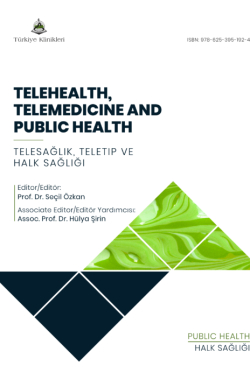Telehealth as a Climate Change Adaptation Strategy
Emine Didem EVCİ KİRAZa
aAydın Adnan Menderes University Faculty of Medicine, Department of Public Health, Aydın, Türkiye
Evci Kiraz ED. Telehealth as a climate change adaptation strategy. In: Özkan S, ed. Telehealth, Telemedicine and Public Health. 1st ed. Ankara: Türkiye Klinikleri; 2024. p.57-61.
ABSTRACT
Monitoring the health impacts of climate change (HICC) and efforts to adapt are new. It does not have a fixed methodology that is reflected in the legislation and that is in common practice. It can be said that it is too early to discuss how telehealth applications should be included in climate change adaptation strategies; it can also be emphasized that it is an accelerating tool for accelerating adaptation. In this section, HICC, the protection of health from the negative effects of climate change and the adaptation of the health sector to climate change are discussed and the areas of need for telehealth use are revealed. World Health Organization (WHO) stated in 2021 health and climate change survey that there is need to integrate climate change signals with health surveillance systems. Health data must be included in the current climate and sectoral vulnerability and risk analyzes. Thanks to telehealth, studies will accelerate.
Keywords: Social vulnerability; public health; global boiling; resilience, psychological; digital technology
Kaynak Göster
Referanslar
- World now likely to hit watershed 1.5 °C rise in next five years, warns UN weather agency. UN News. (Cited: 26 Mayıs 2021) Available from: [Link]
- Climate. Nasa (internet). Global Climate Change Vital signs of the Planet. (Cited: Ağustos 2023). Available from: [Link]
- Hottest July ever signals 'era of global boiling has arrived' says UN chief. UN News. (Cited: 27 Temmuz 2023.) Available from: [Link]
- İklimi Duy (internet). İklimi Duy İklim Değişikliğine Uyum Eğitimi ©2021. (Erişim tarihi: 21 Aralık 2022). Terimler sözlüğü. Erişim linki: [Link]
- Sharma R. Telehealth's Transformation of Climate Change. Think Global Health. (Cited: 14 Şubat 2023) Available from: [Link]
- Smith AC, Patterson V, Scott RE. Reducing your carbon footprint: How telemedicine helps. BMJ. 2007;335(7629):1060. [Crossref] [PubMed] [PMC]
- Haines A, McMichael AJ, Smith KR, Roberts I, Woodcock J, Markandya A, et al. Public health benefits of strategies to reduce greenhouse-gas emissions: overview and implications for policy makers. Lancet. 2009;374(9707):2104-14. [Crossref] [PubMed]
- Yellowlees PM, Chorba K, Parish MB, Wynn-Jones H, Nafiz N. Telemedicine can make healthcare greener. Telemed J E Health. 2010;16(2):229-32. [Crossref] [PubMed]
- Masino C, Rubinstein E, Lem L, Purdy B, Rossos PG. The impact of telemedicine on greenhouse gas emissions at an academic health science center in Canada. Telemed J E Health. 2010;16(9):973-6. [Crossref] [PubMed]
- Scott RE, Perverseff T, Lefebre N. Reducing environmental impact: an example of how e-health can reduce environmental impact and concomitantly improve health. In: Hamou RH, Anwar SA, eds. Proceedings of The 1st Annual Conference on e-Health: The Virtual Dimensions of Health and Environment-Empower, Enhance, Enforce; 2009, p.101-10.
- Gullison RE, Frumhoff PC, Canadell JG, Field CB, Nepstad DC, Hayhoe K, et al. Environment. Tropical forests and climate policy. Science. 2007;316(5826):985-6. [Crossref] [PubMed]
- Lokmic-Tomkins Z, Borda A, Humphrey K. Designing digital health applications for climate change mitigation and adaptation. Med J Aust. 2023;218(3):106-10. [Crossref] [PubMed]
- Chan TC, Killeen J, Griswold W, Lenert L. Information technology and emergency medical care during disasters Acad Emerg Med. 2004;11(11):1229-36. [Crossref] [PubMed]
- Nicogossian AE, Doarn CR. Armenia 1988 earthquake and telemedicine: lessons learned and forgotten. Telemed J E Health. 2011;17(9):741-5. [Crossref] [PubMed]
- Doarn CR, Merrell RC. Spacebridge to Armenia: a look back at its impact on telemedicine in disaster response. Telemed JE Health. 2011;17(7):546-52. [Crossref] [PubMed]
- Nasu Y, Ashida N, Kanzaki H, Sagawa S, Tsuji M. Efficient health information management systems using wireless communications technology to aid disaster victims. J Med Syst. 2012;36(4):2689-95. [Crossref] [PubMed]
- Kost GJ, Tran NK, Tuntideelert M, Kulrattanamaneeporn S, Peungposop N. Katrina, the tsunami, and point-of-care testing: optimizing rapid response diagnosis in disasters. Am J Clin Pathol. 2006;126(4):513-20. [Crossref] [PubMed]
- Bollinger RC, McKenzie-White J, Gupta A. Building a global health education network for clinical care and research. The benefits and challenges of distance learning tools. Lessons learned from the Hopkins Center for Clinical Global Health Education. Infect Dis Clin North Am. 2011;25(2):385-98. [Crossref] [PubMed] [PMC]
- Mars M. Health capacity development through telemedicine in Africa. Yearb Med Inform. 2010:87-93. [Crossref]
- Mars M. Building the capacity to build capacity in e-health in Sub-Saharan Africa: the KwaZulu-Natal experience. Telemed e-Health. 2012;18(1):32-7. [Crossref] [PubMed] [PMC]
- Al Knawy B, Adil M, Crooks G, Rhee K, Bates D, Jokhdar H, et al. The Riyadh Declaration: the role of digital health in fighting pandemics. Lancet. 2020;396(10262):1537-9. [Crossref] [PubMed]
- 2021 WHO health and climate change global survey report. Geneva: World Health Organization; 2021. Licence: CC BY-NC-SA 3.0 IGO.

